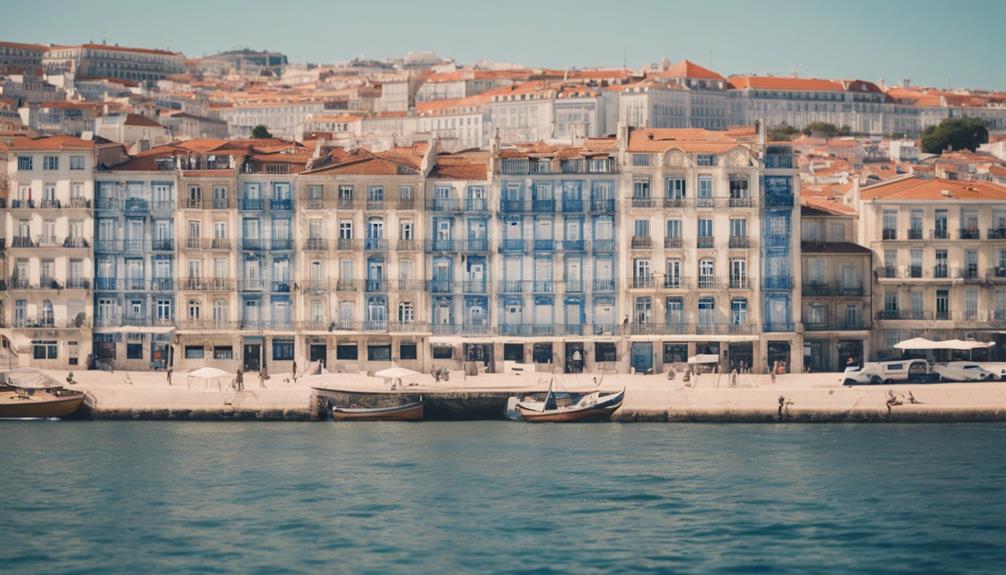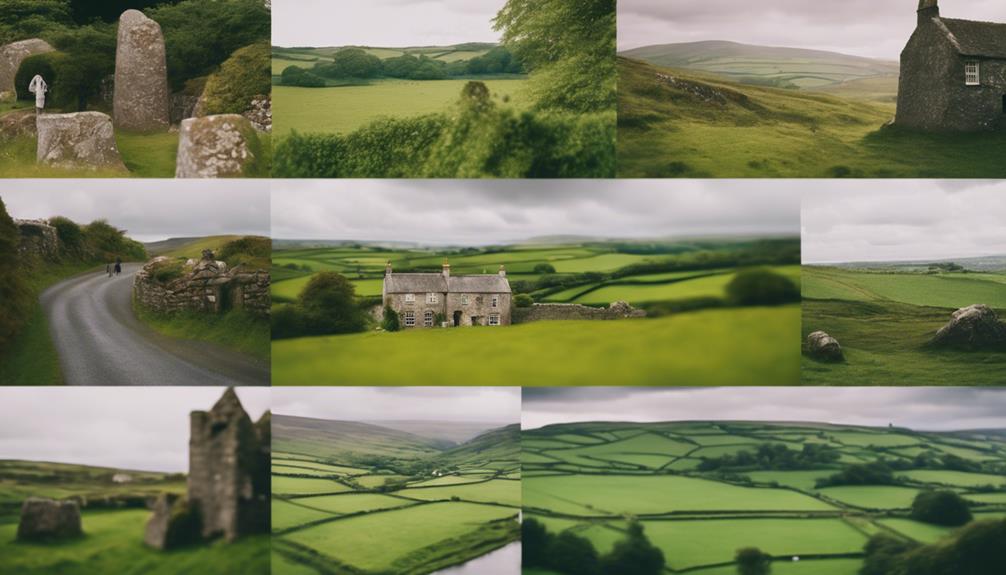Immerse yourself in Lisbon's charm through its iconic azulejo tile facades and scenic seaside views. These glazed ceramic tiles, originating from the 13th century, adorn the city with intricate blue, yellow, and white designs. Reflecting Moorish, Renaissance, and Baroque influences, they uniquely blend artistry and history. Strolling through districts like Alfama and Belém, you'll encounter a rich tapestry of vibrant tile facades narrating Lisbon's vibrant past and cultural heritage. Coastal treasures along the waterfront depict maritime scenes, adding to the city's allure. Discover more about Lisbon's tile traditions and seaside allure by exploring further.
Key Takeaways
- Lisbon's tile facades blend Moorish influences and vibrant colors, reflecting the city's artistic heritage.
- Seaside setting influences coastal tile designs, showcasing maritime themes and cultural influences.
- Tiles along the waterfront depict ships, sea creatures, and navigational instruments, honoring Lisbon's seafaring past.
- Coastal tile treasures create mesmerizing mosaic effects with polished tiles, enhancing the city's charm.
- Modern interpretations of tile designs combine tradition with innovation, reflecting Lisbon's contemporary aesthetic appeal.
Azulejo: A Portuguese Art Form
Azulejo, a mesmerizing Portuguese art form, was introduced by Arabs in the 13th century and has since become a prominent feature in Lisbon's architectural landscape. These glazed ceramic tiles boast intricate designs, often showcasing blue, yellow, and white palettes that depict historical, religious, and everyday scenes.
Azulejos aren't only prevalent in Portugal but also widely seen adorning buildings, sidewalks, and even Lisbon Metro stations. The term 'azulejos' originates from the Arabic word for polished stone, emphasizing the influence of Arab culture on Portuguese tile art.
Inspired by the Alhambra in Spain, azulejos in Portugal have evolved to include a diverse range of colors and styles, transforming Lisbon into a vibrant and colorful masterpiece. The intricate patterns and vibrant hues of azulejos contribute significantly to the unique charm and visual appeal of Lisbon's architectural aesthetics, making them a must-see feature for visitors exploring the city.
Historical Significance of Lisbon's Tiles

Lisbon's tiles hold a significant place in the city's history and culture. They showcase a blend of traditional tile-making traditions, reflecting Portugal's artistic heritage.
Through intricate designs and colorful patterns, these tiles narrate stories of Lisbon's past, serving as a visual language that connects the city's cultural tapestry.
Tile-Making Traditions
The historical significance of tile-making traditions in Lisbon dates back to the Moorish influence in the 13th century. Ceramic tiles, often adorned with intricate geometric shapes, especially in blue and white, have been a hallmark of Lisbon's architectural landscape for centuries.
These tiles, influenced by Moorish design, evolved over time to incorporate elements from the Renaissance, Baroque, and modernist eras, creating a unique blend of styles. The use of blue, yellow, and white hues in Lisbon's tiles reflects the city's rich artistic heritage and cultural identity.
The tradition of tile-making in Lisbon extends beyond mere decoration; it serves as a medium for storytelling, depicting historical events, religious themes, and scenes from everyday life on building exteriors. The vibrant and colorful tile facades in Lisbon attract visitors from around the world, offering a visual journey through the city's past and present artistic expressions.
Cultural Storytelling Through Tiles
Immerse yourself in Lisbon's rich cultural tapestry as you explore the historical significance of its alluring tiles, each intricately designed to narrate the city's vibrant past. The tile murals adorning Lisbon's facades aren't merely decorative; they're windows into the city's soul, showcasing its diverse influences and storied past.
From intricate geometric patterns influenced by Moorish designs to elaborate Baroque and Art Nouveau styles, each tile holds a piece of history waiting to be discovered.
Every tile tells a unique story, whether depicting scenes from Portuguese history, religious events, or everyday life. The story behind each tile is a tribute to the craftsmanship and artistry that went into creating these visual masterpieces.
As you wander through Lisbon's streets, these tiles serve as more than just embellishments; they serve as a living art form that connects you to the rich tapestry of Portuguese culture and history.
Let these tiles guide you through the city's evolution, preserving its cultural identity for generations to come.
Colorful Facades of Lisbon

Lisbon's colorful facades boast vibrant tile patterns that showcase a rich historical significance and architectural diversity.
The intricate azulejos, blending Moorish, Baroque, and Art Nouveau influences, adorn the city's buildings with scenes of historical events, religious motifs, and maritime themes.
As you explore Lisbon's streets, you'll encounter a visual tapestry of diverse color palettes and patterns that define the city's unique artistic identity.
Vibrant Tile Patterns
Adorned with vibrant tile patterns, the facades of Lisbon's buildings showcase a fusion of Moorish influences and Portuguese artistic identity. The colorful tiles not only add an artistic flair but also tell a story of the city's rich history. Each intricate design reflects a mix of artistry and cultural significance, creating a unique visual experience as you wander through Lisbon's streets.
The vibrant colors and patterns on the facades are more than just decorative elements; they're a tribute to Lisbon's heritage and creativity. The intricate tile work is a blend of traditional Portuguese aesthetics and Moorish craftsmanship, capturing the essence of both cultures in a mosaic of beauty.
As you admire the colorful tile facades, you can't help but appreciate the attention to detail and the skill involved in creating these works of art. The combination of historical details and vibrant colors makes Lisbon's buildings not just structures but living pieces of art that breathe life into the city's streets.
Historical Significance
The colorful facades of Lisbon, dating back to the 16th century, intricately blend Moorish, Renaissance, and Baroque influences, embodying the city's rich historical significance.
These vibrant tile facades, with their geometric patterns and bold colors ranging from cobalt blue to sunny yellows, serve as a visual tapestry of Lisbon's past. The use of azulejos on facades not only adds to the aesthetic appeal but also reflects Portugal's former colonies through the incorporation of intricate designs and symbols.
Throughout Lisbon, these tiled facades tell a story of maritime exploration, cultural exchange, and artistic evolution. The tradition of decorating buildings with tiles not only showcases the city's architectural heritage but also highlights the practical benefits of protection and insulation that these tiles provide.
Each neighborhood in Lisbon boasts its own unique style of tile work, showcasing a blend of traditional craftsmanship and modern interpretations that seamlessly merge contemporary art with historical elements. Lisbon's colorful facades stand as a tribute to the city's enduring legacy and creative spirit.
Architectural Diversity
Explore the architectural diversity of Lisbon through its vibrant and intricate tile facades that narrate a colorful tale of artistic fusion and historical legacy.
The city's facades are a sight to behold, with a plethora of colors that reflect Lisbon's lively energy and cultural richness. Traditional azulejo tiles, characterized by their white base and floral motifs, add a unique charm to Lisbon's buildings, turning the city into a vibrant masterpiece of decorative tiles.
Modern artists in Lisbon have taken this tradition a step further by combining traditional tile styles with contemporary design elements, resulting in facades that are both unique and eye-catching. The use of geometric figures, as well as human and animal representations on Lisbon's facades, adds depth and character to the city's architectural landscape, showcasing a blend of old-world charm and modern creativity.
When wandering through Lisbon's streets, be sure to look up and admire the colorful tapestry of facades that tell a story of artistic evolution and cultural identity.
Artistry in Lisbon's Architecture

Immerse yourself in Lisbon's architectural charm, where artistry flourishes through intricate tile facades and historic narratives. The city's signature tile art, known as azulejos, can be seen adorning buildings in a striking black and white motif.
One prominent artist, Maria Keil, made significant contributions to Lisbon's architectural landscape through her innovative use of tiles in public spaces. These decorative elements not only add a visual appeal to the city but also serve as a reflection of Lisbon's rich cultural heritage and artistic innovation.
The intricate designs of the azulejos depict a wide range of subjects, from historical events to everyday life scenes, all rendered in vibrant colors that captivate the viewer's imagination. As you explore Lisbon's streets, you'll encounter these stunning tile facades that not only showcase the city's identity but also contribute to its unique artistic ambiance.
The combination of tile art and Lisbon's seaside setting creates a picturesque backdrop that seamlessly blends artistry with natural beauty, making every corner of the city a work of art waiting to be discovered.
Seaside Charm of Lisbon

Nestled along the Atlantic Ocean, Lisbon's seaside charm enchants visitors with its vibrant maritime culture and stunning views. The city's proximity to the coast not only influences its colorful tile facades but also shapes its lively atmosphere. Lisbon's coastal location provides an invigorating ocean breeze that adds to the allure of its historic neighborhoods adorned with beautiful tiles.
The combination of seaside charm and intricate tile work creates a truly unique and alluring experience for those exploring the city. The maritime culture of Lisbon is deeply ingrained in its identity, reflected in the bustling port activities and the seafood-centric cuisine that delights locals and tourists alike. The city's connection to the sea is evident in its architecture, with buildings echoing the colors of the ocean and the vibrant energy of the waterfront.
Whether you're strolling along the promenade or relaxing at a seaside cafe, Lisbon's seaside charm is sure to leave a lasting impression on you.
Exploring Lisbon's Tile Districts

Lisbon's vibrant tile districts like Alfama and Belém offer a rich tapestry of intricate and historic tile facades reflecting the city's cultural heritage. As you wander through these neighborhoods, you'll find tiles everywhere, creating a mesmerizing display of colors and patterns that tell the story of Lisbon's past and present.
Alfama, the birthplace of fado music, is a treasure trove of hidden gems where you can discover colorful tiles adorning its narrow streets and historic buildings.
Belém district, known for its major sights and museums, showcases beautiful tile work that transforms ordinary facades into exquisite pieces of art.
Lisbon's unique city palette inspires designers to incorporate Moorish touches and historical details from the city's tile facades into modern spaces, showcasing how this traditional art form continues to influence contemporary design.
Immerse yourself in the Portuguese identity as you explore these districts, where each tile carries a piece of Lisbon's history and cultural richness.
Azulejos in Everyday Life

Explore how azulejos play a significant role in everyday life across Lisbon, enriching the cityscape with their vibrant designs and historical significance. In Lisbon, you will find these ceramic tiles not only on historical buildings and churches but also in more commonplace locations like cafes, restaurants, and residential areas. Azulejos come in various styles, from traditional geometric patterns to modern interpretations, all reflecting Lisbon's cultural heritage and artistic flair. Even metro stations showcase these tiles, adding a touch of elegance to daily commutes.
To give you a better idea of the diversity of azulejos in everyday settings, here is a glimpse into their presence:
| Everyday Location | Type of Azulejo | Description |
|---|---|---|
| Residential Areas | Individual Tiles | Brightly colored motifs on white tiles create a picturesque atmosphere. |
| Cafes | Geometric Patterns | Intricate designs adorn walls, inviting you to appreciate the artistry. |
| Metro Stations | Historical Narratives | Azulejos tell stories of Lisbon's past, making your commute culturally enriching. |
Lisbon's Coastal Tile Treasures

The intricate tile facades along Lisbon's seaside showcase unique designs inspired by the city's maritime heritage and cultural influences. These coastal tile treasures can be found adorning buildings along the waterfront, adding a touch of artistic flair to the city's coastal charm.
When exploring Lisbon's coastal areas, you'll notice that tiles often depict scenes of ships, sea creatures, and navigational instruments, paying homage to the city's seafaring past. The small polished tiles used in these facades create a mesmerizing mosaic effect, reflecting the sunlight and enhancing the vibrant colors of the designs.
Whether you're strolling along the promenade or waiting for a train at a metro station, take a moment to admire the beauty of these coastal tile treasures that adorn Lisbon's architectural landscape. Each tile tells a story, blending tradition with modern aesthetics to create a visual feast for visitors and locals alike.
Contemporary Tile Designs in Lisbon

Embracing a fusion of tradition and innovation, modern tile designs in Lisbon captivate with their vibrant colors and intricate patterns. These contemporary tile designs in Lisbon blend the traditional construction material of azulejos with modern interpretations, creating a stunning visual landscape throughout the city. Artists in Lisbon infuse their unique creations with elements that reflect the vibrant culture and rich history of the region.
The modern interpretations of azulejos in Lisbon feature a mix of colors, patterns, and themes that push the boundaries of traditional tile art. Lisbon's contemporary tile facades boast a combination of geometric shapes, intricate details, and artistic flair that add a fresh and innovative touch to the city's architectural scenery.
The new tile designs not only showcase the creativity of local artists but also contribute to the city's overall aesthetic appeal, making Lisbon a must-visit destination for art and design enthusiasts.
Frequently Asked Questions
What Are the Tile Sidewalks in Lisbon?
Tile sidewalks in Lisbon, known as calçadas, are intricate mosaic designs made from limestone and basalt shards. Originating after the 1755 Lisbon earthquake, they were mandated by Dom Joao II to pave Portugal's roads.
Reflecting local heritage, designs in towns like Pinhão and Lagos feature motifs like grape-growing and fishing industries. In Sintra, star-shaped mosaics pay homage to the town's name, showcasing artistic diversity.
This mosaic sidewalk technique spread across Portugal in the mid-19th century.
Why Does Lisbon Have so Many Tiles?
Why does Lisbon have so many tiles?
Lisbon's rich history of Moorish and Manueline influence, coupled with a tradition of storytelling through azulejos, contributes to the abundance of tiles.
The practicality and durability of tiles in Portugal's warm climate and seaside location make them a popular choice.
The vibrant colors and intricate designs dating back to the 15th century enhance Lisbon's architectural charm, serving as a cultural and artistic expression of the city's identity.
What Are Two Ways That Azulejos Are Still Relevant in Modern Portugal?
In modern Portugal, azulejos remain relevant due to their adaptability to different architectural styles, providing timeless elegance to buildings.
Additionally, custom-designed azulejos are in high demand, with artisans and workshops creating unique tiles for contemporary spaces.
The blend of traditional techniques with innovative designs showcases the country's rich cultural heritage while meeting the aesthetic needs of modern design trends.
Azulejos continue to be a popular choice for both interior and exterior decoration, reflecting Portugal's artistic legacy.
What Is the Significance of the Azulejos?
The significance of azulejos lies in their portrayal of Portugal's history, culture, and artistic heritage. These traditional ceramic tiles serve as visual storytellers, capturing moments from the past and reflecting the country's identity.
Through intricate designs and vibrant colors, azulejos adorn buildings and landmarks, showcasing a unique artistic style that has evolved over centuries. Their presence not only adds beauty to Portugal's architectural landscape but also preserves and celebrates its rich cultural legacy.
Conclusion
To sum up, Lisbon's tile facades and seaside setting offer a unique blend of artistry and charm that captivate visitors from around the world.
Whether you're strolling through the colorful districts, admiring the historical significance of the azulejos, or simply enjoying the coastal views, there's no shortage of beauty to be found in Lisbon's architectural treasures.
So, next time you visit this vibrant city, be sure to take in the stunning tile work that truly sets Lisbon apart.










